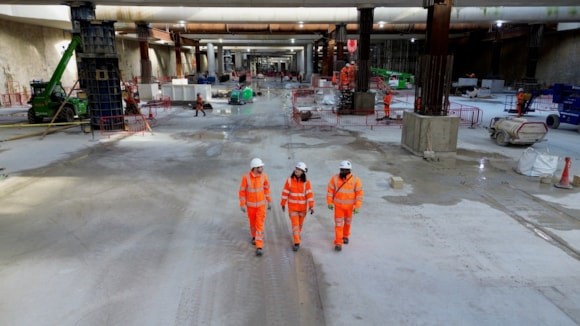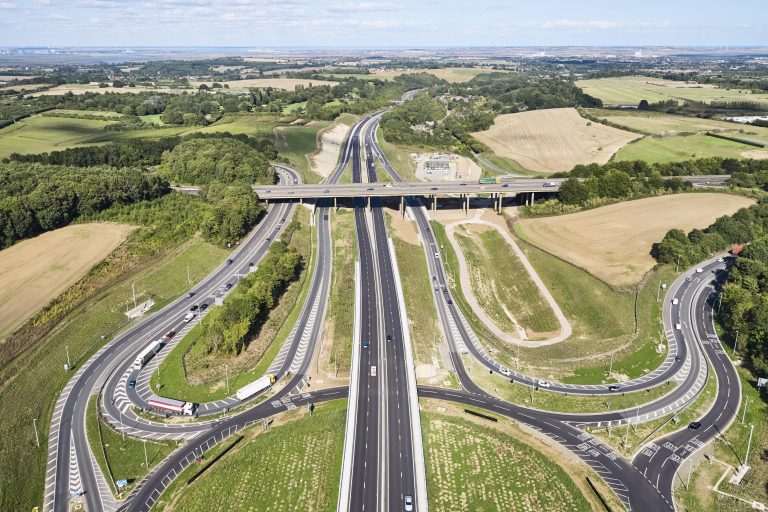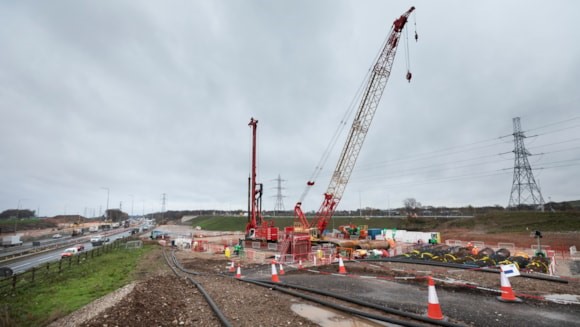The foundations for Britain’s newest high-speed railway station have been completed at Old Oak Common in London, marking a significant step forward for the HS2 project. The 850-metre-long underground station base, which will house six platforms for high-speed trains, has been constructed using 76,000 cubic metres of concrete and 17,000 tonnes of reinforced steel. The base slab covers 45,000 square metres – equivalent to more than six football pitches – and reaches nearly two metres thick at its deepest point. Construction began in April 2023 and required 91 separate concrete pours to complete. The station is being built by Balfour Beatty Vinci SYSTRA joint venture (BBVS). At peak construction, the base slab works employed up to 50 steel fixers and 20 joiners, supported by a team of engineers. The completion of the base slab represents an important milestone in creating this major new transport superhub for London and the UK. When complete, the station will be one of the best connected in the UK, with the six underground platforms allowing high-speed services to reach central London in one direction and the West Midlands in the other, with services running further north via the existing railway. Additionally, eight surface-level platforms are being constructed to provide an interchange to the Great Western Railway, Elizabeth Line and Heathrow Express. HS2’s Project Client for Old Oak Common, Peter Gow, said: “Completing the base slab of the underground station box is a key milestone in building HS2’s new super hub station in West London. This is the final stage in completing the foundations for the high-speed station, and will be where HS2 tracks are laid, platforms are constructed and the station building and roof and built above. “At Old Oak Common we are making significant progress in building this state of the art, environmentally friendly, transport hub which will be a key part of the HS2 route.” The excavation of the box was completed in the summer of 2024 with sub-contractor Expanded removing 1.3 million tonnes of London clay. To create the base slab, the team installed blinding, layers of shingle for drainage before a matt could be laid on top. Then a 1.85 metre high reinforcement layer was installed– with the team fixing the steel by hand. Finally, concrete was poured to compete the slab, competing the foundations for the high-speed station area of Old Oak Common. London Concrete, part of the Holcim Group, has supplied the concrete used to complete the base slab from a dedicated batching plant on site. Over 90% of the concrete used for the base slab was manufactured on site, reducing lorry movements and CO2 emissions. In addition, low carbon ECOPact concrete has been used, contributing to the drive to reduce carbon used in construction. Measures such as this, as well as the innovative design, have contributed to the station being recognised as BREAAM outstanding, putting it in the top 1% of environmentally friendly buildings in the UK. Steve O’Sullivan, Project Director for Balfour Beatty VINCI SYSTRA, joint venture said: “With the completion of the base slab, we have achieved another significant milestone at Old Oak Common. In less than two years, we have carried out 91 concrete pours of between 600m3 and 1 000m3 each. Logistically, this has been a huge undertaking, requiring detailed planning and collaboration between HS2, Balfour Beatty VINCI SYSTRA and our supply chain partners. “This latest step will enable us to progress to the next phase of works, with construction of the high-speed platforms already underway”. Work is now underway on the six HS2 service platform with wall frameworks being installed ready for concrete pouring. The high-speed platform slabs are currently being manufactured by Explore in Worksop and installation will begin this spring. The team are also working above the base slab to construct the ground floor level of the station before the superstructure can be built, creating the vibrant station environment. Tunnelling work to connect the station to the HS2 network is being done by HS2’s London tunnels contractor, Skanska Costain STRABAG JV. In the eastern section of the box, the team are preparing to launch two giant tunnelling machines towards Euston. In the western side of the box, the team will excavate the tunnel using the sprayed concrete lining method. Old Oak Common station in West London is being built on land previously used for railways depots. The site sits between the Elizabeth Line depot and Great Western Mainline which is being realigned so Elizabeth Line, Great Western Mainline and Heathrow Express trains can call at the station providing unrivalled connectivity. As Britain celebrates 200 years of the Great British railways this year, the progress at Old Oak Common is important part of Britain’s railway future. Building, Design & Construction Magazine | The Choice of Industry Professionals














